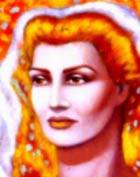|
What strikes you, observing the paintings of Giovanni Truncellito, is the perfect balance
between colours, shapes and space: once could say that his whole life, projected through
the symbols of his work, has a rhythmic nature where measurements, mathematics and fantasy
all smoothly entwine, causing no friction in a harmonic and predicted flow.
Maybe his architectural studies led him to un certain type of perfectionism in the
realization of the images which are depicted in his paintings, but this is definitely not
the only matrix of the oneiric refinements of that magical world which can be observed in
so many small details: I think it is important to consider the gift attributed to him at
birth by Euterpe, the Muse which took him into her arms gifting him with his musical
talent.
In his art there is not one shape you do not remember or that does not give you the
feeling of already seen, of already known and it is easily recognisable to all those who
love myth in all its expressions and who avert the sensation of wellbeing when entering
contemporaneously into these various levels.
I must confess in fact to be most fascinated by the intensity of the symbols which are
always so intimately bound to one another that they make the reading apparently easy, and
then push you towards a more profound observation in order to see further and better
savour the composition of the image. A dichotomist game where the binary meaning of each
piece is most seductively attractive.
Because if there is white there must also be black, if reds appear so will greens to
balance them, and if the dominant colour is blue the orange colours will draw to red; but
always in a most particular way to transmit an occult message, through a symbol which will
emerge from the dream in order to capture us.
The dream: the unconscious mental state which gives you access to the world populated by
immortal primordial forces, the place from where Giovanni's images derive. I think it is
clear that they originate from the state of unawareness which has been given liberal
access to the present day, where it was not denied an important role for the growth of the
individual in its multiple facets, constantly in its dual reign of reality-unreality.
There can not be in fact contingent reality without its hidden double identity: as if, a
follower of Horus, could observe his double in the follower of Seth, without however
passing judgement.
Giovanni paints and observes, observes and paints without separating himself from the
painting, from the colours and thousand brushes: he is determined to bring his work in the
other reality to a maximum, that which he is creating in the vest of Demiurgo. At the same
time he wants the freedom to dream and allow himself to wander open-eyed in this
profoundness without being victim of occult forces that would want to imprison him.
One could assume a passion for Veda, sacred Indian texts, without undermining the most
noticeable Greek influence: in his pictures he repeatedly declares that the contact with
his soul may belong to the state of wakefulness, the state of sleep or the state of
meditation. An artist, son of the Muse and father of his paintings, he claims his
pertaining to the human race through a genuine and spontaneous humanity typical of who is
able to turn his sense of humour towards himself, making himself strong through his
weakness and weak from him own strength.
One thing is certain: he wishes no interference in this monologue with himself and in
order to listen to his inner soul he chooses the external reality in relation to what is
most pertinent to his creative possibilities.
Could he be different? I don't think so, because Art is not a profession: it is an essence
of being which takes over oneself, condemning one to live in a specific way, obliging one
to not always make advantageous choices and limiting one to adepts which are often in
contrast with our own being, with that part of ourselves which would like us to be
different, less exigent and more accommodating towards the reality we live in.
Music comes to Giovanni's assistance. Euterpe, with the sound of flutes, composes
celestial music that populates the pictures with gods and human beings surrounded in a
magical aura: reading carefully between the lines we can discover that the characters are
capable of emerging from their refuges at night and invading our habitats recreating an
Arcadia.
Chicca Guglielmi Morone
|

|
|